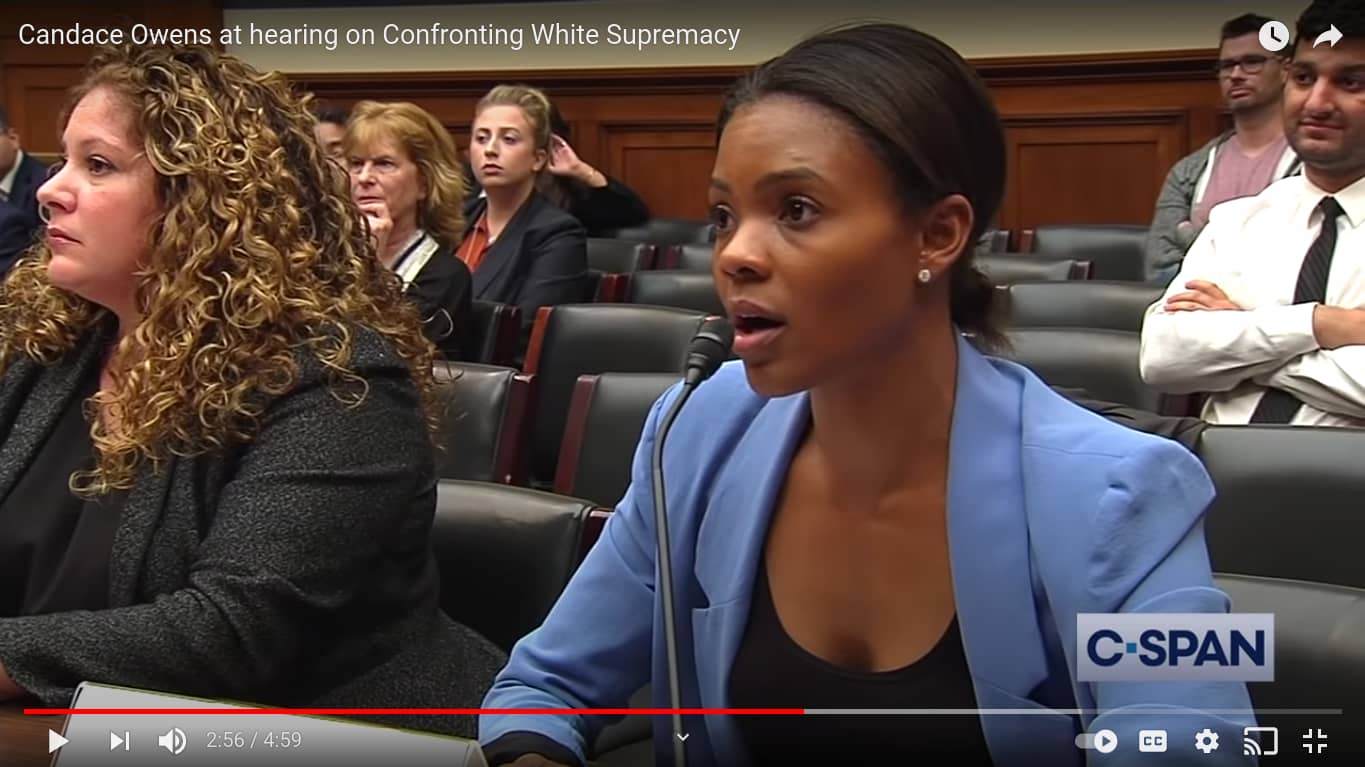Fear has always been associated with the topic of white supremacy. It has been instilled in the minds because of the violence that often comes along with it. Lynchings, beatings, and riots have been ways that represent it and are rooted in its history. Aside from the violence that comes with white supremacy, some symbols convey the message like Confederate flags, swastikas, and the Gadsden flag. Today there is some controversy whether or not it is still around or is still a threat. A video of a hearing on confronting white supremacy was published in September 2019. In the video two subcommittees of the House Oversight and Reform Committee converse about the possible threat of white supremacy and white nationalism in the United States. A key spokesperson who expressed their beliefs about the issue at hand is Candace Owens, a known conservative with far-right leaning ideologies. Today we will be breaking down and disproving Owens’ false and misleading claims on the downplaying of white supremacy and white nationalism.
Expert 1 Candace Owens; Far-Right Conservative (2:42)
Before we dive into the video we need to discuss the main woman in the video, Candace Owens. Owens is best known for being an American conservative, an author, and a political commentator. An article published by Philadelphia Magazine tells the story of when Owens went to the University of Pennsylvania and the students “had never heard of [her].” They reference how two years ago she “was virtually unknown to the greater public.” She really had no platform at the time and people were confused as to why she was even there. Owens’ past has also had some contradictory components to her career now. She is an African American woman who was a part of the Democratic party who then shifted to Republican, and now she is using the “Blexit movement,” as she calls it, to “ge[t] the black community to leave the Democratic Party.” So with her past of shifting ideologies and motives, we should be prudent when it comes to taking her word into account.
Expert 2 Mark Meadows; Former House of Representative (1:36)
Another expert we should look into that is mentioned in the video is Mark Meadows. He is a Republican politician who served as a House Representative for South Carolina’s 11th Congressional District from 2013-2020. He then served as the 29th White House chief of staff from 2020-2021. Tim Alberta, the chief political correspondent at Politico Magazine has named Meadows as fickle in his article “How Mark Meadows Became the White House’s Unreliable Source.” Politifact has also named several claims of Meadows as half true, half false, and false. Bill McCarthy a staff writer for Politifact and Punditfact previously debunked Meadows when he “wrongly claim[ed] Obama removed census citizenship question in 2010.” In the article previously mentioned by Tim Alberta, he shares when Meadows “went on the record with Reuters to contradict what he told other reporters on the condition of anonymity earlier in the day—comments that contradicted what the president’s own doctor had broadcasted to the public after 18 hours without official word on the president’s medical condition.” With his contradictory statements made on the president’s condition, he was deemed untrustworthy. Alberta also shares, “Meadows, […is] always up to something, always playing the angles, always dealing in smoke and mirrors.” Comparing him to smoke and mirrors make Meadows’ words embellishments of the truth and misleading. So to conclude on Meadows, he has a rocky past with credibility and telling the full truth. So when he backs up Owens in the hearing we should be wary of his words and statements.
Claim 1 “White Supremacy and White Nationalism ranks nowhere near the top of the issues facing black America” (2:42).
Continuing on, to put it plainly, the video shows Owens using Mark Meadows’ time he gave her to voice their shared belief that white supremacy and white nationalism isn’t an issue in black America. She claims other problems within black America rank higher. Other board members were on her side of the discussion. On the contrary, to her statement, several articles are stating that white nationalism is a problem not just in black America but in all of America. In an article published in January of 2021 by Christine Fernando and Noreen Nasir titled “Years of White Supremacy Threats Culminated in Capitol Riots”, Lecia Brook who is mentioned in the article, is the chief of staff for Southern Poverty Law Center and mentions how “displays of white supremacy are not new.” She then goes on to describe, “Confederate symbols have been displayed more prominently, including at smaller-scale white supremacist rallies and by counterprotesters carrying Confederate flags at Black Lives Matter gatherings across the country.” The presence of these symbols and rallies are threats to all American life. In another article by Robert Farley, a deputy managing editor, he states, “[A]nti-black or African American hate crime rose 16 percent to 2,013 incidents in 2017.” His data and facts come from the Justice Department’s FBI data. He then goes on and says, “The Anti-Defamation League reports a 182 percent increase in incidents of the distribution of white supremacist propaganda, and an increase in the number of rallies and demonstrations by white supremacy groups, from 76 in 2017 to 91 in 2018.” Overall throughout the research, they all have one thing in common and that’s disagreeing with Owens’ statement that white supremacy isn’t an issue. If it wasn’t an issue facing Americans it wouldn’t be consistently apparent in American life today.
Claim 2 “White Supremacy isn’t as big of a threat as people make it out to be” (3:32)
Next in the video, Owens makes the claim people make white supremacy a bigger threat than what it is made out to be. Now there truly isn’t a way to solidly prove that but numbers collected and provided by the FBI completely contradict Owens’ statement. Robert Farley states, “The Montgomery, Alabama-based Southern Poverty Law Center, which tracks domestic extremism, last month reported a 7 percent rise in hate groups in the U.S. in 2018, with 1,020 groups identified. White nationalist groups, specifically, surged nearly 50 percent, growing from 100 chapters in 2017 to 148 in 2018.” The growing number of hate groups also increases the threat of white supremacy and the safety of Americans. In an additional article Christine Fernando and Noreen Nasir contribute, “Confederate flags and white supremacist symbols were also present at the 2017 ‘Unite the Right’ rally in Charlottesville that turned deadly after a car mowed into counterprotesters.” The violence present at the rally only goes on to support the ongoing threat of white supremacy. Going back to Farley and his article he also reports, “About 58 percent of the hate crimes in 2017 were motivated by race/ethnicity/ancestry.” This statistic and showing the expansion of white supremacy and hate towards African Americans further proves the threat is ongoing. Predominantly the research demonstrates white supremacy is a threat in American and is often violent.
Claim 3 “The media manipulates what republicans, the president and what conservatives say.” (3:09)
Owens continues on her tangent about how white supremacy isn’t a threat and accuses another committee member of doing “what the media does live.” Which according to her is to “manipulate what [she] said to fit [their] narrative.” James Clayton, a North American technology reporter, wrote the article “Social Media: Is it really biased against US Republicans?” By insinuating there is manipulation in the media there has to be bias, and in the article Clayton explains how “it’s difficult to definitively prove social media is biased.” He then shares when Congressman Jim Jordan who has similar beliefs to Owens and Meadows says, “I’m just going to cut to the chase, Big Tech is out to get conservatives” and Clayton counters, “This was something the CEOs denied.” The CEOs denying Big Tech is out to get conservatives only exemplify how Owens’ statement is misleading. Siva Vaidhyanathan, who is a media studies professor at the University of Virginia, was mentioned in the article when she states, “I think it’s a mistake to look at it as a right-wing versus left-wing bias.” Vaidhyanathan says, “ [T]hat while “some pretty extreme right-wing” posts have spread widely on social media in the US, their popularity isn’t proof of the platforms suffering from structural bias.” Vaidhyanathan mentioning this further disproves Owens and makes her statement misleading. Generally the research states we can’t definitely prove bias and manipulation in the media meaning Candace Owens can’t either.
Conclusion
Ultimately, during this court hearing, Candace Owens makes misleading statements regarding the dangers and violence that come with white supremacy. White supremacy and white nationalism are a threat in America in the day-to-day lives of others. As Joel Rubin, a former U.S deputy assistant secretary of state, says, “White supremacist terrorism has been a feature, not an outlier, of American life.” To help ease the fear and anxiety others have towards white supremacy, we have to take note of the dangers and their negative effects. We can recognize the experiences of others and listen to ways we can help. We can acknowledge. We can listen. We can share. Most importantly, we can change.
Featured image is a screenshot from the video “Candace Owens at hearing on Confronting White Supremacy.”





What do you think?
Show comments / Leave a comment